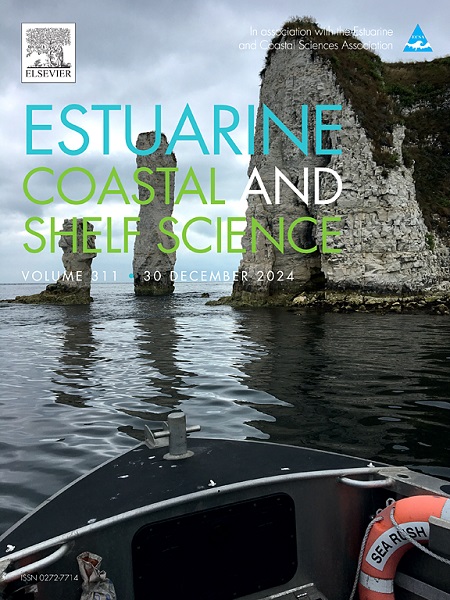Bottom-up regulation of food webs in a high-latitude environment depends on season and habitat type
IF 2.6
3区 地球科学
Q1 MARINE & FRESHWATER BIOLOGY
引用次数: 0
Abstract
Food source and quality influence benthic trophic pathways and health status of scavengers at high latitudes. We hypothesised that benthic responses to food sources differing in nutritional value vary across habitats and seasons. We therefore deployed Baited Remote Underwater Video systems with four different types of bait in coastal waters (≤20 m) of the Nain Archipelago (Labrador, Canada). Strong seasonality and a variety of habitat types (e.g., mud and rhodolith beds) characterize this high latitude environment. We deployed an in situ feeding experiment in those habitats during the ice-covered spring and ice-free fall. We selected bait commonly found in the region that fluctuates according to environmental conditions and biotic interactions: herring (Clupea harengus), lion's mane jellyfish (Cyanea capillata), kelp (Laminaria sp.), and crab (Chionoecetes opilio). We deployed herring and kelp in both seasons but the absence of lion's mane in spring only allowed for fall deployments, and we therefore used the crab treatment in spring instead. We observed significantly lower feeding activity in the spring compared to the fall deployments regardless of bait type. The highly structural rhodolith beds supported higher feeding activity than any other habitat and more diverse species composition than the flat muddy habitat. In all habitats, the number of visitors feeding on the fish treatment was significantly higher than to the lion's mane, likely reflecting its higher nutritional value. Species composition between treatments differed significantly, where toad crab Hyas spp. and whelk Buccinum undatum dominated the fish treatment. Only one species consumed kelp and crab treatments, sea urchin Strongylocentrotus droebachiensis and whelk, respectively. Overall, season tempered the intensity of scavenger initial response to a food fall deployments whereas habitat and treatment regulated key players and intensity. Bottom-up effects on benthic scavengers therefore depend on season, habitat, and food source.
在高纬度环境中,食物网自下而上的调节取决于季节和栖息地类型
食物来源和质量影响高纬度地区底栖动物的营养途径和健康状况。我们假设底栖生物对营养价值不同的食物来源的反应因栖息地和季节而异。因此,我们在Nain群岛(加拿大拉布拉多)的沿海水域(≤20米)部署了带有四种不同类型诱饵的带饵远程水下视频系统。强烈的季节性和多样的生境类型(如泥和rhodolith床)是高纬度环境的特征。在冰雪覆盖的春季和无冰的秋季,我们在这些栖息地进行了原位喂养实验。我们选择了在环境条件和生物相互作用波动较大的区域中常见的饵料:鲱鱼(Clupea harengus)、狮鬃水母(Cyanea capillata)、海带(Laminaria sp.)和蟹(Chionoecetes opilio)。我们在两个季节都使用鲱鱼和海带,但春季没有狮鬃,只能在秋季使用,因此我们在春季使用螃蟹处理。我们观察到,无论饵料类型如何,春季饵料活动明显低于秋季饵料。高结构的rhodolith床比任何其他生境支持更高的摄食活性和比平坦泥泞生境更多样化的物种组成。在所有栖息地中,吃鱼的游客数量明显高于吃狮子鬃毛的游客数量,这可能反映了它更高的营养价值。不同处理间物种组成差异显著,以蟾蜍蟹和海螺为主。只有海胆和海螺分别以海带和蟹为食。总体而言,季节调节了食腐动物对食物掉落部署的初始反应强度,而栖息地和处理则调节了主要参与者和强度。因此,底栖食腐动物自下而上的影响取决于季节、栖息地和食物来源。
本文章由计算机程序翻译,如有差异,请以英文原文为准。
求助全文
约1分钟内获得全文
求助全文
来源期刊
CiteScore
5.60
自引率
7.10%
发文量
374
审稿时长
9 months
期刊介绍:
Estuarine, Coastal and Shelf Science is an international multidisciplinary journal devoted to the analysis of saline water phenomena ranging from the outer edge of the continental shelf to the upper limits of the tidal zone. The journal provides a unique forum, unifying the multidisciplinary approaches to the study of the oceanography of estuaries, coastal zones, and continental shelf seas. It features original research papers, review papers and short communications treating such disciplines as zoology, botany, geology, sedimentology, physical oceanography.

 求助内容:
求助内容: 应助结果提醒方式:
应助结果提醒方式:


